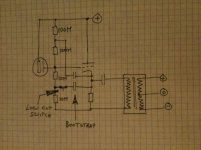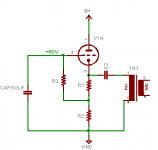The CCS will allow you to bootstrap that input resistor. You don't need a negative rail if you capacitively couple the input.
You're very close.
The input IS a capacitor and you can take advantage of this.
Also, most capsules work with 60V charge or less. 125V would probably suck the diaphragm in.
The best way IMO to arrange this all is to bias the capsule and the grid of the CF at about 60V, halfway up the 120V supply;
e.g. connect the capsule diaphragm to 0V (to keep it from being a dust and spit attractor), backplate and grid at +60 charged through a high megohm resistor bootstrapped off the tap of the cathode voltage divider. The cathode is cap coupled to the output transformer.
This is the circuit of the AKG C60, which uses an AC701K. 6922 is IMO a great choice for this because it has a decent heater-below-cathode voltage rating and the high gm makes for low output Z.
I don't think you need the CCS, just bootstrap the rg off a tap near the "top" of the rk for bias. I would make this about 60V which will polarize the capsule through a high megohm resistor, and shoot for about 1/2 mA or so of standing current. Not sure what your cap switching will do; it might just be an attenuator. Lots of mics use a cap in the capsule circuit as a pad... it forms a capacitive voltage divider with the capsule C which is about 50pf-100pf
If you are interested in going this way I can try to scan this and post it - the AKG C60 schematic. Extremely simple, the tube, the capsule and 3 resistors... (plus the output cap and xfmr in the output circuit, that's it.)
Oh and one section of the tube at low current is sufficient. It's not like a phonostage with relatively low input impedance (even mm) -- here the capsule equivalent noise resistance is on the order of megohms (frequency dependent...) which completely dominates in most well designed circuits.
Last edited:
So if I try something like this?
I guess I can use higher resistance values, but I'm scared. Ok, seriously, it's b/c then I need to throw in another order to Mouser, and I aint planning any for a while. Just blew this month's budget on 6W6 tubes and a bunch of tolex, among other things
I guess I can use higher resistance values, but I'm scared. Ok, seriously, it's b/c then I need to throw in another order to Mouser, and I aint planning any for a while. Just blew this month's budget on 6W6 tubes and a bunch of tolex, among other things
Attachments
Last edited:
Just to clarify, the bootstrapping capacitor can be switched out to make a low cut filter. But that cap is there to bootstrap the input resistors.
For a real 2.5 cm capsule it will be around 400 Hz low cut filter.
For a real 2.5 cm capsule it will be around 400 Hz low cut filter.
Agree, a little high. But I rechecked my stash, and it's 10meg ohms those resistors are
Good idea, a new niche...
Will look up some of those expencive high ohm resistors for medical/avionic equipment.
No need for expensive ones: just increase 10 times the one that you drew already. As I said before, I use 18 megaohm bootstrapped.
Edit: 10 megaohm may be good, if you don't intend it to be used to measure woofers.
A hint: one resistor from a bootstrapped divider.
Last edited:
A hint: one resistor from a bootstrapped divider.
Sweet. Thanks.
So if I try something like this?
I guess I can use higher resistance values, but I'm scared. Ok, seriously, it's b/c then I need to throw in another order to Mouser, and I aint planning any for a while. Just blew this month's budget on 6W6 tubes and a bunch of tolex, among other things
The capsule should be polarized with ~60V (assuming a "typical" large diaphragm capsule). I don't think it will work as well if the voltage is too far off that.
Here's a recreation of the AKG C60 schematic; my paper copy is barely readable. It has an idle current of about 0.5mA which I think is a good starting place. From that you can work out R1 and R2, then R3 can probably be on the order of 10's of Mohms because it will be bootstrapped.
cheers,
Michael
PS if you just want one high megohm resistor I'll put one in an envelope for you... I'll go see what I've got; pm me
Attachments
Last edited:
The capsule should be polarized with ~60V (assuming a "typical" large diaphragm capsule). I don't think it will work as well if the voltage is too far off that.
Here's a recreation of the AKG C60 schematic; my paper copy is barely readable. It has an idle current of about 0.5mA which I think is a good starting place. From that you can work out R1 and R2, then R3 can probably be on the order of 10's of Mohms because it will be bootstrapped.
cheers,
Michael
PS if you just want one high megohm resistor I'll put one in an envelope for you... I'll go see what I've got; pm me
Some more gratuitous comments and ramblings..
The AKG C61 uses the 7586 tube with the same circuit, at a little over 2mA standing current. This would improve the output cable drive capability of the mic. The grid resistor on the C61 is 200M even though it's bootstrapped.
The 6922 and 7586 have similar gm and mu.
PS if you just want one high megohm resistor I'll put one in an envelope for you... I'll go see what I've got; pm me
And PM me for 1gΩ resistors.
John
Where did you source those? I'd love to get some 1/4" jobs at a price less than the bend-over-and-tell-me-you-love-it Bruel & Kjaers.
Aren't they called DPA these days? Which capsules do you use? I have a pair of 4003s with small diaphragms that are electret capsules. Super low noise and sensitive.
I have a few B&K 4145 capsules, 1" omnidirectional with super low noise and full range response, that I'd like to build a pair of recording mics around. I got them off ebay for cheap (like $50 with a boatanchor SLM attached...) but had to do 4 transactions to get one good clean pair and a workable spare. The 4145 has a steel diaphragm and 200V polarization.
Reading up on the noise question a little, it would appear that it's difficult to design a vacuum tube preamp ( the part in the mic) with with gain that has less noise than the capsule noise. It's not clear that simply decreasing the equivalent noise R, e.g. paralleling sections, helps. Historically this was solved on vacuum tube measurement mics (B&K) by using cathode follower preamps having unity gain.
The capsule noise is 1/f due to the equivalent noise resistance being a capacitance. Smaller capsules thus have higher self-noise. A-weighting in the measurements makes the capsule noise look smaller because the A-weighting curve counteracts the 1/f curve somewhat.
Some references I recommend:
AIP Handbook of Condenser Microphones
Ed. Wong & Embleton - AIP Press
ISBN 1-56396-284-5
The Microphone Handbook
John Eargle - Focal Press
ISBN 0-240-51961-2
Microphone Engineering Handbook
Michael Gayford - Focal Press
ISBN 0-7506-1199-5
Last edited:
Thanks for great help. There is hope for humanity after all
My Summer holiday is about to start, and although it is good to get away from my day job for a bit, it means the wife will demand more at home, probably leaving less time for my poor lonely soldering iron;(
Still, I'll sneak down to my dark pit now and then and get this mic done.
My Summer holiday is about to start, and although it is good to get away from my day job for a bit, it means the wife will demand more at home, probably leaving less time for my poor lonely soldering iron;(
Still, I'll sneak down to my dark pit now and then and get this mic done.
When used for biasing rather than I/V conversion a neon bulb (such as venerable NE-2) can be used in place of extremely high value resistor as long as its striking voltage isn't exceeded, according to GE's "Glow lamp manual 2nd edition" which can be downlaoded from P(ete) Millet's website.
Aren't they called DPA these days? Which capsules do you use? I have a pair of 4003s with small diaphragms that are electret capsules. Super low noise and sensitive.
For my purposes (recording acoustic instruments/vocals from several meters away), 4003 will work, but are not optimum. Their claim to fame is the high SPL capability. Not that I would turn them down if they were at a super-attractive price, but at $2700 the pair... ouch.
Can the Microtech Gefell capsules be bought by non-OEMs?
One more textbook design:
An externally hosted image should be here but it was not working when we last tested it.
6AU6 in triode mode as a cathode follower? Interesting.
V, M1, M2 switch - does this select for frequency response?
Yes, the settings are: Vocal, Music(1), Music(2). The AKG C60 has a similar selector labeled "0", "-7", "-12". The C61 has the same selector but uses an additional tapped inductor. I believe the inductance of the output transformer is being taken advantage of. Maybe you can play with the parafeed calculator; this could be a better approach than trying to do LF roll off by putting junk in the capsule circuit...
"Can the Microtech Gefell capsules be bought by non-OEMs?" I've not done so personally, but I think it's worth a try, and would be interested in the outcome. (Oh I remember, I asked at AES2006 and was given an encouraging answer, but never followed up) They still have the recipe there. The 4003 has self-noise of 16db(A) re 20uPa, ansd can be used inside a grand piano with LVB himself playing ;-). Good enough for me. But I have a pair of vintage tube omni Gefells with big diaphragms that just sound... mmmm...
I've never seen anything but triode connection in a tube mic. Maybe the noise?
Michael
Last edited:
I've never seen anything but triode connection in a tube mic. Maybe the noise?
Michael
I wonder. The ENR of a good pentode will be overwhelmed by the combination of the biasing resistor and capsule capacitance at lower frequencies. Even at higher frequencies, for that matter. The current noise should dominate over partition noise, and even partition noise might be dealt with in a pentode cathode follower connection by using a low impedance bypass from the screen to the cathode.
- Status
- This old topic is closed. If you want to reopen this topic, contact a moderator using the "Report Post" button.
- Home
- Live Sound
- Instruments and Amps
- Tube for high input Z

